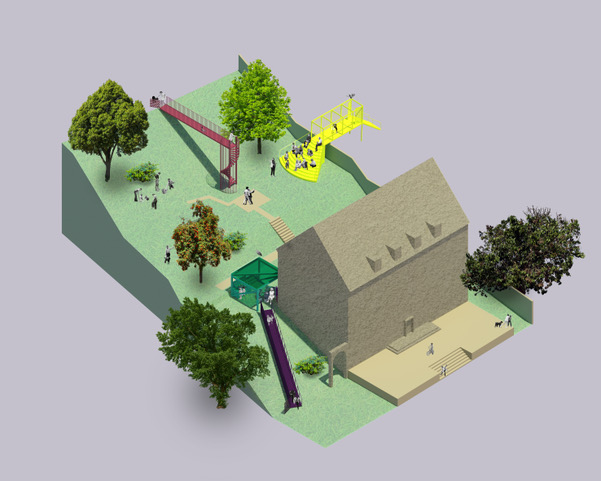Press conference: August 18, 2022, 4 p.m Ruth Buchanan “A Garden with Bridges (spine, stomach, throat, ear)” in Mönchengladbach, Germany at the Abteiberg Museum
In the center of the city, not far from the historic abbey and the Abteiberg Museum, construction begins on three walk-through bridge-like steel sculptures, inviting the public to experience a place that seeks to overthrow the hierarchies that shape our society. Supplemented by a pavilion as a social center, a “garden with bridges” is being created here. With the start of construction, which has brought together an unusually broad alliance of very different supporters since the commission was signed on November 13, 2018, a long process of collaboration between the New Patrons Initiative, the Mönchengladbach unemployment center and the students at the nearby Stiftisches Humanistisches Gymnasium, is leading to success.
The project goes back to a request from the unemployment center and the high school for social opening between the buildings. Both actors had turned to the New Patrons in order to develop a meeting place that was open to all users but protected, where no social group would be excluded. The mediator Kathrin Jentjens was able to win over the New Zealand artist Ruth Buchanan who, after extensive research on site and several joint planning meetings with the two groups, designed a “garden with bridges”.
In summer 2021, a diverse design workshop program made it clear that the artist was trying to increase the opportunity for encounters on the Abteiberg. In a three-part series, ranging from gardening and dance workshops to film screenings, Ruth Buchanan discussed central issues of the project with the participants: work, care and physicality.

The four sculptural elements of the garden, which, in addition to the bridge elements, include a pavilion with an outdoor kitchen, are named after parts of the body – spine, stomach, throat, ear – and thus refer, among other things, to the importance of the garden as an organism. Buchanan’s intervention deals with the cultural history of the Abteiberg with reference to architectural elements from the surrounding area, such as stair of the Museum Abteiberg designed by Hans Hollein and references to the historically charged architecture of the unemployment center as a former home of the Hitler Youth. The care of the garden is included in the school curriculum and conveys ecological awareness and independent action, which is enriching for biology lessons. The Jukomm im Step youth center is also a regular guest with its young people. Further cooperations are in preparation to further activate the place from within.
